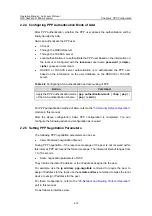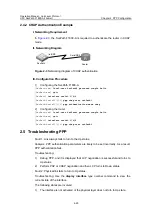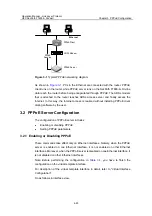
Operation Manual - Link Layer Protocol
H3C SecPath F1800-A Firewall
Chapter 3 PPPoE Configuration
4-22
Chapter 3 PPPoE Configuration
3.1 PPPoE Overview
3.1.1 Introduction to the PPPoE Protocol
Point-to-Point Protocol over Ethernet (PPPoE) connects an Ethernet host to a remote
access concentrator through a simple bridging device. Through PPPoE, a remote
access device can achieve control and accounting over each accessing user. PPPoE
has higher performance price ratio than the traditional access method. So it is widely
used in a series applications including community networking. It is also adopted in the
popular broadband access mode ADSL.
PPPoE employs Client/Server mode, in which it encapsulates PPP packets into
Ethernet frames and provides point-to-point connection over the Ethernet.
PPPoE has two different phases: the discovery phase and the PPP session phase.
z
The discovery phase
When a host initiates a PPP session, it must confirm the remote Ethernet MAC
address through the discovery phase and create a PPPoE session ID. Different from
PPP, the discovery phase of PPPoE creates a Client/Server relationship rather than
the peer relationship created by PPP. During the discovery phase, a host (client) can
discover an access concentrator (server). After the discovery phase, the host and the
concentrator can establish PPPoE session through the MAC address and session ID.
z
The PPP Session phase
At the beginning of the PPP session phase, the host and access concentrator transmit
PPP data, perform various PPP negotiation and data transportation over PPP. PPP
packets, as the payload of PPPoE frames, are encapsulated into Ethernet frames and
sent to the peer of a PPPoE link. In this case, all Ethernet frames are unicast.
For the description of PPPoE in detail, refer to RFC2516.
3.1.2 Introduction to PPPoE Application
PPPoE is widely used in ADSL broadband access applications. In general,
a host
must be installed with PPPoE client dialing software in order to access the Internet
through ADSL.
H3C series routers serve as PPPoE client (namely the PPPoE client
dialing) while the SecPath F1800-A supplies PPPoE server, by which the user can
access the Internet without installing client dialing software on his PC. Moreover, all
PCs on the same LAN can share the same ADSL account.





















